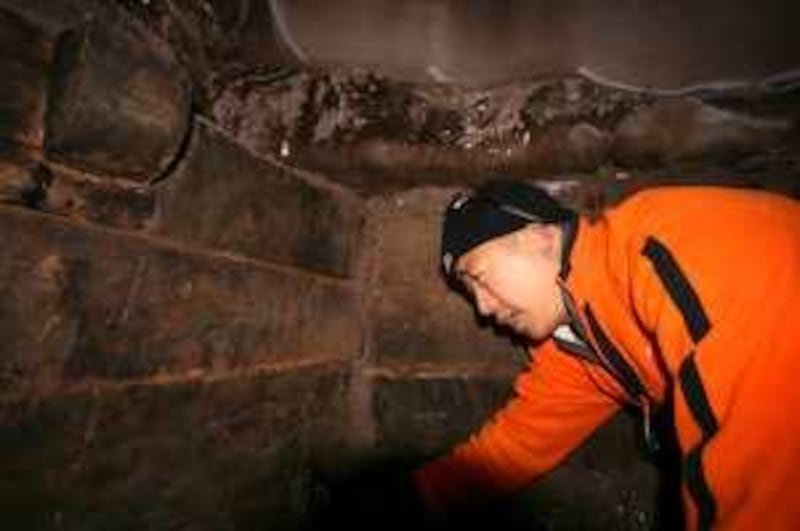ISTANBUL // When a team of Chinese and Turkish explorers unveiled what they claim are remains of the legendary ark that the prophet Noah is said to have used to survive the Great Flood thousands of years ago, they may have expected fame and adulation. Instead, their announcement has triggered scorn by other experts and an investigation by Turkish authorities.
Noah's Ark Ministries International (Nami), a Hong Kong-based evangelical group, became the latest organisation to claim to have found Noah's Ark. Mentioned in both the Bible and the Quran, Noah's ship filled with animals is said to have come to rest on a mountain after the flood. There has been a series of alleged sightings and discoveries of the ship on Mount Ararat in eastern Turkey in recent decades, all of which are disputed. Other theories say the ark landed on Mount Cudi, further south, as mentioned in the Quran.
Unveiling its findings, Nami said late last month that a team of climbers from China and Turkey had found a wooden structure at about 4,000 metres, far above the treeline and any human dwelling, on Mt Ararat during an expedition last year. "The search team and I personally entered a wooden structure high on the mountain," Man-fei Yuen, a Nami member, said, according to the organisation's website. "We believe that the wooden structure we entered is the same structure recorded in historical accounts and the same ancient boat indicated by the locals," Mr Yuen added in reference to local folk tales about a boat on the mountain.
Pictures and video footage provided by the group showed members of the expedition inside what looked like a wooden building enclosed by rock and the ice of a glacier. At a press conference in Hong Kong, participants presented pieces of wood that were said to be 4,800 years old and presumed to have come from the ark, press reports said. Nami said it had not conducted any excavation at the site, whose exact location on the mountain is to be kept secret until Turkish authorities seal it off before scientific research can start.
But the findings failed to convince the sceptics. "This is very comical," Ahmet Ali Arslan, a mountaineer who grew up near Mt Ararat and who has taken part in several expeditions looking for the ark, said in a telephone interview from Konya in central Turkey, where he teaches at a university. "I think it's very doubtful" that the findings presented in Hong Kong were genuine, he said. "They are just after the publicity." During one of his own expeditions in 1989, Mr Arslan took pictures of what he believes is the true resting place of the ark, but his own findings were also greeted with doubts. He said that over time various explorers had found suspected hints in many different places on the mountain. "Noah must have had a whole fleet," he joked.
Randall Price, a US scholar and president of World of the Bible Ministries, a Christian group, also cast doubt on Nami's alleged discovery. In an e-mail to supporters that was posted on the internet, Mr Price said some of the photos of the supposed ark showed cobwebs in the corners of the rafters, something impossible at 4,000 metres. There also was a suspicion that the wood may have been carried to the site on Mt Ararat recently, he added. Mr Price said he would join an expedition on Mt Ararat this summer.
While the debate about the Nami findings rages on, Turkey's government has started to investigate whether the Chinese-Turkish climbers acted illegally. Authorities want to know how the wood pieces presented in Hong Kong were taken from Turkey, said Ertugrul Gunay, Turkey's minister for culture and tourism, according to press reports. Turkish law carries stiff sentences to prevent the smuggling of artefacts.
The minister also hinted that he does not believe the expedition team had the necessary permits to climb the mountain, on the border with Armenia, access to which is restricted by security forces battling smugglers and Kurdish rebels in the region. At least some Turkish officials were involved in the Nami project, however. Murat Guven, the deputy governor of Agri province, where Mt Ararat is located, was present during the press conference in Hong Kong. After his return to Turkey last week, he said the climbing team had stumbled upon the remains of the ark "by coincidence", the Vatan daily reported.
Mr Guven said Turkey had much to gain from the ark expeditions. "We have the principal aim to turn Mt Ararat into a centre of faith for the whole world and attract millions of tourists," he said. Mr Gunay, the minister, also said the debate about the ark was good for the tourist trade. Agri province, one of Turkey's poorest regions, is not alone in hoping for some additional cash generated by tourists looking for the ark. One week before the Nami announcement, Abdurrahman Boztas, a journalist in the southern city of Adana, called a press conference to announce that he had found Noah's vessel. Contrary to what most theories say, Noah did not use a ship but a float, Mr Boztas said, and landed not on Mt Ararat or Mt Cudi, but on the Taurus mountain range close to Adana.
tseibert@thenational.ae






